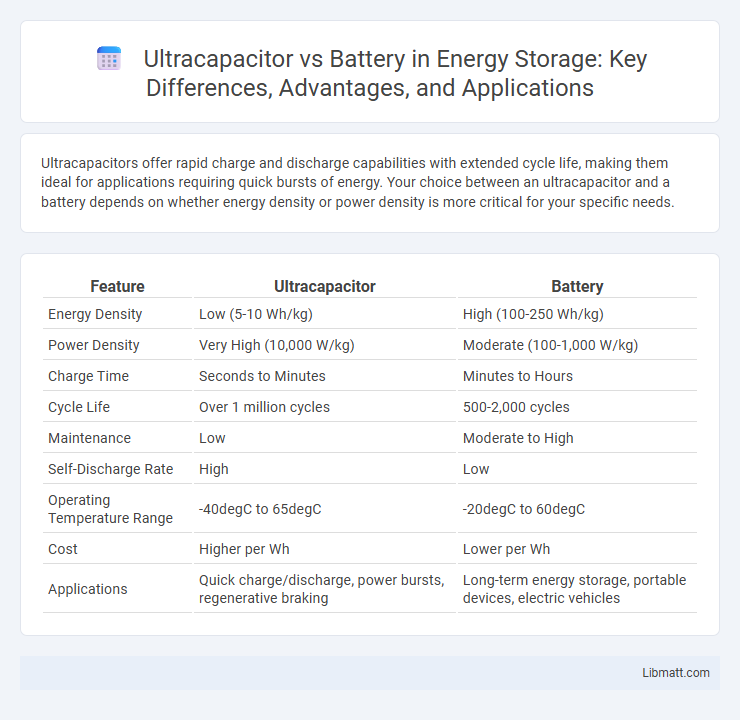Ultracapacitors offer rapid charge and discharge capabilities with extended cycle life, making them ideal for applications requiring quick bursts of energy. Your choice between an ultracapacitor and a battery depends on whether energy density or power density is more critical for your specific needs.
Table of Comparison
| Feature | Ultracapacitor | Battery |
|---|---|---|
| Energy Density | Low (5-10 Wh/kg) | High (100-250 Wh/kg) |
| Power Density | Very High (10,000 W/kg) | Moderate (100-1,000 W/kg) |
| Charge Time | Seconds to Minutes | Minutes to Hours |
| Cycle Life | Over 1 million cycles | 500-2,000 cycles |
| Maintenance | Low | Moderate to High |
| Self-Discharge Rate | High | Low |
| Operating Temperature Range | -40degC to 65degC | -20degC to 60degC |
| Cost | Higher per Wh | Lower per Wh |
| Applications | Quick charge/discharge, power bursts, regenerative braking | Long-term energy storage, portable devices, electric vehicles |
Introduction to Ultracapacitors and Batteries
Ultracapacitors store energy through electrostatic fields, enabling rapid charge and discharge cycles with high power density but lower energy density compared to batteries. Batteries rely on chemical reactions to store and release energy, offering higher energy density but slower charge rates and limited cycle life. Understanding these fundamental differences highlights ultracapacitors' suitability for applications requiring quick bursts of power and batteries' advantage in long-term energy storage.
How Ultracapacitors Work
Ultracapacitors store energy through electrostatic charge accumulation on high-surface-area electrodes separated by an electrolyte, enabling rapid charge and discharge cycles. Their operation relies on the physical separation of charges rather than chemical reactions found in batteries, resulting in higher power density and longer cycle life. This unique mechanism allows ultracapacitors to deliver bursts of energy quickly and efficiently, ideal for applications requiring fast energy transfer and frequent recharge.
How Batteries Work
Batteries generate electricity through electrochemical reactions that involve the movement of ions between the anode and cathode within an electrolyte, storing energy in chemical form. When discharging, electrons flow through an external circuit providing power, while during charging, the chemical process is reversed to store energy. The capacity and lifespan of batteries depend on the materials used and the efficiency of these electrochemical processes.
Energy Density Comparison
Ultracapacitors have significantly lower energy density compared to traditional batteries, typically storing around 5 Wh/kg versus batteries that can store between 100 to 250 Wh/kg. This fundamental difference limits ultracapacitors' use for long-duration energy storage but makes them ideal for applications requiring rapid charge and discharge cycles. Energy density advantages of batteries allow them to power devices for extended periods, while ultracapacitors excel in high-power, short-term energy delivery.
Power Density Differences
Ultracapacitors exhibit significantly higher power density compared to traditional batteries, enabling rapid charge and discharge cycles ideal for applications requiring quick bursts of energy. Your choice between an ultracapacitor and a battery depends on whether immediate high power output or long-term energy storage capacity is more critical for your device. Ultracapacitors deliver power densities up to 10 times greater than batteries, making them superior for peak power demands.
Charge and Discharge Rates
Ultracapacitors exhibit significantly faster charge and discharge rates compared to batteries, enabling rapid energy delivery and quick recharging within seconds. Batteries, such as lithium-ion or lead-acid types, typically have slower charge and discharge cycles due to chemical reactions, limiting their power density and cycle life. This distinct advantage makes ultracapacitors ideal for applications requiring high power bursts and frequent cycling.
Lifespan and Durability
Ultracapacitors offer significantly longer lifespans, often exceeding one million charge-discharge cycles, compared to traditional batteries which typically last between 500 to 1,500 cycles. Their durability is enhanced by the ability to withstand extreme temperatures and rapid charging without capacity degradation, unlike batteries that suffer from chemical wear and capacity loss over time. This makes ultracapacitors ideal for applications requiring frequent cycling and robust performance under harsh environmental conditions.
Applications in Modern Technology
Ultracapacitors excel in applications requiring rapid charge and discharge cycles, such as regenerative braking systems in electric vehicles and power backup for grid stabilization. Batteries are better suited for long-duration energy storage in devices like smartphones, laptops, and renewable energy systems due to their higher energy density. Your choice between ultracapacitors and batteries depends on whether your application prioritizes quick energy delivery or sustained power supply.
Cost and Environmental Impact
Ultracapacitors offer longer lifecycle and higher charge-discharge efficiency compared to traditional batteries, leading to lower maintenance and replacement costs over time. Although their initial cost per unit is higher, ultracapacitors contain fewer toxic materials, reducing environmental harm and enabling easier recycling. Batteries, often relying on lithium and cobalt, incur greater ecological costs due to mining and disposal challenges, increasing their overall environmental footprint.
Future Trends in Energy Storage
Ultracapacitors offer rapid charging and discharging capabilities with longer cycle life compared to traditional batteries, positioning them as key components in future energy storage systems. Advances in materials science are enhancing ultracapacitor energy density, narrowing the gap with lithium-ion batteries for applications requiring quick bursts of power. Integration of hybrid energy storage solutions combining ultracapacitors and batteries is driving innovations for electric vehicles and grid stability, optimizing performance and durability.
Ultracapacitor vs Battery Infographic

 libmatt.com
libmatt.com